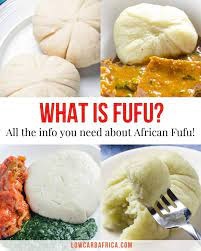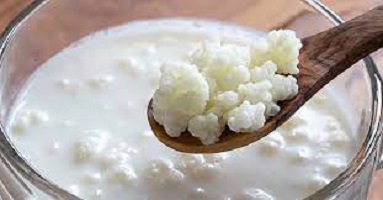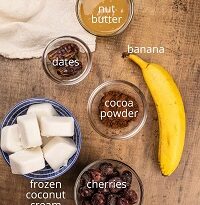What is Fufu made of? What is Fufu Dish, How to Make & Eat?
What is Fufu made of? What is Fufu Dish, How to Make & Eat?

Fufu is an easy yet tasty dish to prepare. It is served with a rich and savory soup or stew, such as egusi soup, okra soup, ewedu soup (Jute leaves), or light soup.
It’s a great addition to soups, stews, and meats because it’s easy to swallow and doesn’t need chewing, making it a cuisine that people of all ages can enjoy.
In some parts of West Africa, fufu refers to any swallow that is served with the local soup.
When you order fufu dish in Nigeria, you will be served cassava fufu, which is also referred to as akpu or Santana depending on where you are in the country.
This staple cuisine is known as fou fou, foo foo, fo fo in other west African nations such as Cameroun, Ghana, Sierra Leone, and Senegal. The process is the same regardless of where it comes from if it is made from cassava pulp. It’s a silky, smooth swallow that may be either hard or soft to the touch.
Related Articles >>>>
- Oatmeal fufu Recipe (Nigerian Healthy Swallow)
- Wheat Meal Swallow: Nigerian Wheat Flour Meal Fufu Recipe
- Fufu Recipe Nigeria – How to Make Fufu from Potatoes
- What Is Fufu Made Of | West African Fufu | Fufu Recipe
- What is African Fufu? – Nigerian Fufu and Soup Recipes
- Light Soup: How to Make Best Ghanaian Fufu and Light Soup
What is Fufu? What is Fufu made of?
Foofoo is made from cassava, which is also referred to as yuca. It is a starchy root vegetable, similar to sweet potatoes, russet potatoes, and yams.
It can be fried, baked, and made just like potatoes; however, it becomes very smooth, doughy, and elastic when made into fufu.
Though traditionally made from cassava, fufu’s definition has widened due to time to include eba, green plantains, amala, cocoyam, corn, pounded yam, semolina, and other swallow foods.
Origins and History
The word ‘fufu’ is derived from the Twi language, which is spoken by the Akan peoples of Ghana’s central and southern regions, as well as southeastern Côte d’Ivoire.
The word ‘foofoo’, ‘foufou’, or ‘fufuo’ refers to the method fufu is created and can also be spelled ‘foofoo’, ‘foufou’, or ‘fufuo’.
Fufu is supposed to have originated in modern-day Ghana and extended from there to many other West African countries, as its name suggests.
Enslaved populations transported it to the Americas, where it was altered to employ locally available ingredients and became a staple cuisine in several Caribbean countries, including Haiti, Jamaica, Cuba, and Puerto Rico.
Types of Fufu – Different Types of Fufu Food
- Cassava fufu(Akpu) – fermented cassava.
- Eba – dried cassava (garri)
- Pounded yam (yam fufu) – boiled yams.
- Plaintain fufu – green plantains.
- Amala – yam powder (elubo)
- Semolina – durum wheat.
- Oatmeal swallow – blended oats.
- Tuwon shinkafa – cooked, mashed rice.
Other varieties include:
- Fufu flour
- Fufu powder
- Water fufu
- The Fufu soup
- Fufu dough
- Fufu sauce
What is Fufu Made Of?
Fufu is a mash made out of yuca, yams, or plantains.
What is West African fufu made of? What is African food called fufu?
Fufu is dough formed from boiling and crushed starchy ground supplies such plantains, cassava, or malanga or a mix of two or more.
It is a staple dish across most of West Africa. Enslaved populations carried it to the Americas and adapted it to Caribbean cuisines based on what was available.
What is Nigerian fufu?
Cassava, often known as yuca, is used to make foofoo. Sweet potatoes, russet potatoes, and yams are all starchy root vegetables.
It can be fried, baked, and prepared just like potatoes; but, when converted into fufu, it becomes incredibly smooth, doughy, and elastic.
Nigerian fufu is mostly made from cassava dough, whilst Ghanaian fufu is created from a combination of cassava and plantain.
It is usually made entirely of green plantain and is a popular Ghanaian staple.
Most African/Asian stores in the UK sell plantain fufu flour, which is sold to customers as fufu.
Water fufu, on the other hand, is created from fermented cassava. It’s labeled Placali and can be found in the freezer department; don’t worry, Fermented fufu is the same thing.
What is Yam fufu made of?
Natural yams are boiled and then mashed in a wooden mortar and pestle until smooth and sticky like dough in the traditional fufu preparation.
Pounded yam has a tangy and sour flavor that goes well with full-bodied, well-seasoned meat and vegetable soup.
If you can find cocoyams where you reside, you can add another fufu recipe to your Nigerian menu.
Cocoyam fufu recipe instructions
- Firstly, the cocoyams should be peeled, rinsed, and cut into medium cubes.
- Then, put the chunks of cocoyam in a pot, cover them with water, and cook on medium heat.
- While that’s cooking, combine the cassava flour with half a cup of water to make a mouldable mixture.
- After that, make little balls out of the dough and set them aside.
- After 10 minutes of cooking the cocoyams, add the cassava flour balls and simmer for another 10 minutes, or until a knife can easily pierce the cocoyam pieces.
- Lastly, remove the cocoyams and cassava from the heat and mash them together in a mortar until smooth dough ball forms. You can also use a blender to combine the ingredients, but don’t add any water.
Because cocoyam fufu softens and loses its elasticity with time, it’s best served right after it’s made. Serve with a Nigerian soup of your choice.
Here’s a brief overview of how to prepare cassava dough for fufu using fresh fruit.
- Peeled cassava is sliced into bits. It’s then cleaned and soaked in water, covered, and left to ferment for 3 to 5 days outside.
- This procedure is also beneficial in the removal of contaminants as well as additional starch from cassava.
- While I understand that leaving the cassava outside to ferment may not be practical, it is necessary due to the harsh and pungent odor that the cassava emits while fermenting. This should be OK in an airtight container.
- Drain the water from the cassava after five days; the cassava will be soft to the touch. Put it in a blender with a little water to help it blend, and blend until smooth. Repeat the process until all of the cassava has been used up.
- Squeeze out all of the liquid from the pureed cassava using a cheesecloth. You can save it for another day by hanging it over a bowl. Your placali (water cassava) is ready to eat.
How to Make Cassava Fufu (Nigerian Fufu Recipe)
- In simple stages, learn how to make fufu with cassava dough (Placali).
- Cassava fufu is a popular side dish in Nigeria and other West African countries, often served with soups such as okra soup, egusi soup, and efo riro. With my step-by-step instructions, I’ll teach you how to make it.
- Making fufu from scratch at home is not for the faint of heart, I must say. It takes some effort on your part, but it is well worth it, especially if you reside in the diaspora.
- Because of the time and effort required to prepare it, it is not something I will make every week. However, when I’m in the mood for something nostalgic, I make it.
- Step 1: Place the cassava dough/pulp in a heavy-bottomed pot and break it up with your hands into smaller pieces. Add the water and mix with your hands until the mixture is lump-free and smooth. It would have the consistency of thick double cream.
- Step 2: Turn the heat to medium-low and begin rapidly stirring; the fufu will begin to change color from white to off white. To grind, you’ll need to keep stirring.
- At some point, the fufu will become difficult to stir and stretchy; you will need to add warm water to the mix as needed. Cover the pan pot with its cover and cook for 5 to 10 minutes to allow the steam to properly cook the fufu and obtain the required softness.
- When the fufu is no longer white and the finished product is off-white in color, you know it’s done. Cooked fufu should be portioned into bowls or wrapped in cling film until ready to use. Serve with your favorite soup.
What to serve fufu with
To keep its dampness, fufu is usually served in little balls and wrapped in plastic wrap.
It’s normally paired with a variety of delectable soups and stews, including Egusi, Ogbono, Vegetable, Peanut, and Okro soup, with each person’s preference.
How to eat fufu food
Fufu is best eaten with your hands, and it can also be used to scoop up soup or stew.
Pull a piece of bread from the loaf with your right hand and hold it between your fingers, making a dent with your thumb to allow additional food to fit.
How to Store This Staple Food
Cooked fufu can be kept on the counter for up to 5 days in a cool environment. This swallow is delicious cold with a hot soup.
Ground cassava dough can be frozen for up to a year and kept in the fridge for up to 7 days.
People also ask:
What is traditional fufu made of?
Fufu is a dough formed from boiling and crushed starchy ground supplies such as plantains, cassava, or malangaor a mix of two or more.
It is a staple dish across most of West Africa. Enslaved populations carried it to the Americas and adapted it to Caribbean cuisines based on what was available.
What does fufu taste like?
Fufu’s flavor varies based on the ingredients used in its preparation, but it’s best described as sour, bland, or tangy.
Fufu is frequently served with an African soup, which is usually quite thick and savory, and occasionally hot.
Is fufu made of corn?
Fufu is a starchy West African side dish used with vegetables or soups such as okra soup.
Fufu can be produced with cassava, yams, cocoyams, or corn, among other starchy foods.
Why do you swallow fufu and not chew?
Fufu is a central and western African traditional meal made from a starchy preparation crushed by hand into little balls.
Fufu balls are typically consumed whole, without chewing, to maintain a feeling of fullness in the stomach throughout the day
How healthy is fufu?
Fufu, like many other traditional West African ingredients and meals, has numerous health advantages:
Not only is it low in cholesterol, but it’s also high in fiber, potassium, and resistant starch, which feeds the good bacteria in your stomach and may help decrease inflammation and promote digestive health.
It also includes vitamin C, which may help reduce inflammation and promote digestive health.
Is fufu good for weight loss?
No. The calorie count is still excessive.
How long does it take fufu to digest?
Fufu, for example, takes roughly seven hours to digest, so eating it late at night won’t assure appropriate digestion, according to him.
Is fufu good for the heart?
Fufu is high in protein, fat, carbs, potassium, and low in cholesterol, making it a wonderful source of nourishment.
Does fufu have salt?
Fufu does not need any salt or spice. That’s why you can’t eat fufu by itself; it needs to be paired with a soup or stew.
Is fufu the same as pounded yam?
But fufu is just one of the “mashes” that make up Ghanaian cuisine’s starchy core.
The relatively mundane name for a mash prepared from a white sweet potato popular in coastal West Africa is pounded yam.
It has the same bouncy texture as fufu but a much blander flavor.
Disadvantages of eating fufu
The widespread under-processing of fufu has negative health consequences. This is due to the fact that the cyanide concentration has not been decreased to a non-toxic level.
Women and children are more vulnerable to cyanide poisoning because they are typically the ones who process fufu.


